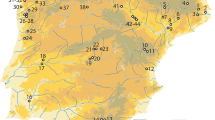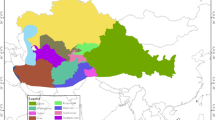Abstract
Most of the early and rich archaeobotanical finds ofLathyrus sect.Cicercula, particularly those of the most ancient periods, came from the Balkan peninsula. It has been found that cultivation ofL. sativus began there in the early Neolithic period, around 6000 b.c.e., as a result of the expansion of Near Eastern agriculture of annuals into the region. This, in turn, encouraged development of a greater variety of legumes by the domestication of an additional native species. Similarly, it is suggested that domestication ofL. cicera in southern France and the Iberian peninsula occurred only after the introduction of agriculture into the area. Cultivation of these two closely related species in adjacent regions led to the raising of a mixed crop in many ancient fields. Lathyrus sativus may perhaps be the first crop domesticated in Europe.
Similar content being viewed by others
Literature Cited
Amaudow, N. 1941. (Über die neuentdeckten prähistorischen Pflanzenreste aus Südbulgarien). God. Sofijsk. Univ. Phys. Math. Fak. 37:17–29. (Bulgarian with German summary.)
Behre, K-E. 1970. Kulturpflanzenreste aus Kāmid el-Lōz. Pages 59–69 in R. Hachmann, ed., Kāmid el-Lōz 1966/67. Rudolf Habelt Verlag, Bonn.
Brunton, G., and G. Caton-Thompson. 1928. The Badarian civilization and predynastic remains near Badari. British School of Archaeology in Egypt, London. [62–63].
Bulle, H. 1909. Orchomenos I. Verlag der K.B. Akademie der Wissenschaften, München. [60].
Buschan, G. 1895. Vorgeschichtliche Botanik der Cultur-und Nutzpflanzen der alten Welt auf Grund prähistorischer Funde. J.V. Krens Verlag, Breslau. [208–209].
de Candolle, A. 1855. Géographie botanique raisonée. Librairie de Victor Masson, Paris, Librairie Allemande de J. Kessmann, Genéve.
—. 1886. Origine des plantes cultivées. 2nd ed. Bibliothèque Scientifique Internationale, Paris.
—. 1967. Origin of cultivated plants. English translation of 2nd ed. Hafner Publishing Company, New York and London.
Costantini, L., and L. Costantini Biasini. 1985. Le piante di Yelkhi. Pages 57–60 in Centra Ricerche Archeologiche e Scavi di Torino per il Medio Oriente e l'Asia. La terra tra i due fiumi. II Quadrante Edizioni, Torino.
-, and C. Tozzi. 1983. Les plantes cultivé es et la conservation des grains pendant le Né olithique des Abruzzes (Italie centrale): Le té moignage du village de Catignano (Pescara). Pages 19A–H in Université de Nice-U.E.R. Civilisations, Centre des Civilisations Traditionnelles Mediterranéennes, éd. Longue duré e et innovation dans le monde mediterrané en. Socié té s Agricoles et Techniques Agraires, Actes du Colloque de Nice 1981. (mimeographed report.)
Courtin, J., and J. Erroux. 1974. Aperçu sur l’agriculture pré historique dans le sud-est de la France. Bull. Soc. Pré hist. Franç. 1:321–334.
Deininger, I. 1891. Adatok kultúrnövé nyeink törté neté hez. A. Lengyel-i öskori telep növé nymar-adványai. A keszthelyi m. kir. Gazdasági Taninté zet 1891-i é vkönyve 21–49 (cited by Hartyányi and Nováki 1975).
Halstead, P., and G. Jones. 1980. Early Neolithic economy in Thessaly—some evidence from excavations at Prodromos. Anthropologika 1:93–117.
Hartyányi, B.P. 1982. (Die von der bronzezeitlichen Wohnsiedlung Tiszaalpár-Várdomb stammende Korn-und Fruchtfunde). Cumania (Archaeologia) 7:133–164, 271-286. (Hungarian with German summary.)
—, and G. Nováki. 1975. Samen-und Fruchtfunde in Ungarn von der Neusteinzeit bis zum 18 Jahrhundert. Agrártört. Szemle 17 (suppl.):l-65.
Helbaek, H. 1958. Plant economy in ancient Lachish. Pages 309-317 in O. Tufnell, ed., Lachish IV. Oxford University Press, London.
—. 1963. Isin Larsan and Horian food remains at Tell Bazmosian in the Dokan Valley. Sumer 19:27–35.
—. 1967. Agricoltura preistorica a Luni sul Mignone in Etruria. Pages 279–282 in C.E. Östenberg, ed., Luni sul Mignone e problemi della preistoria d'Italia. Skr. Svenska Inst. Rom. Ser. in 4, 25. C.W.K. Gleerup, Lund.
—, K.V. Flannery, and J.A. Neely. Prehistory and human ecology of the Deh Luran Plain. University of Michigan, Ann Arbor.
—. 1970. The plant husbandry of Hacilar. Pages 189–244 in J. Mellaart, ed., Excavations at Hacilar I. University Press, Edinburgh.
—. 1972. Samarran irrigation agriculture at Choga Mami in Iraq. Iraq 34:35–48.
Hopf, M. 1961. Pflanzenfunde aus Lerna/Argolis. Züchter 31:239–247.
—. 1962. Nutzpflanzen vom Lernäischen Golf. Jahrb. Röm.-German. Zentralmus. Mainz 9: 1–19.
—. 1973. Frühe Kulturpflanzen aus Bulgarien. Jahrb. Röm.-German. Zentralmus. Mainz 20: 1–47.
Hubbard, R. N. L. 1979. Ancient agriculture and ecology at Servia. Pages 226–228 in C. Ridley and K. A. Wardle, eds., Rescue excavation at Servia 1971–1973: a preliminary report. The Annual of the British School at Athens 74.
Jones, G. 1984. The LM II plant remains. Pages 303–306 in M.R. Popham, ed., The Minoan unexplored mansion at Knossos. Brit. School Athens Suppl. 17. Thames and Hudson, London.
Kajale, M.D. 1977a. Ancient grains from excavations at Nevasa, Maharashtra. Geophytology 7: 98–106.
—. 1977b. On the botanical findings from excavations at Daimabad, a Chalcolithic site in western Maharashtra, India. Curr. Sci. 46 (23):818–819.
Kislev, M.E., and M. Hopf. 1985. Food remains from Tell Qasile. Pages 140–147 in A. Mazar, ed., Excavations at Tell Qasile. The Institute of Archaeology, The Hebrew University of Jerusalem, Jerusalem.
Kroll, H. 1979. Kulturpflanzen aus Dimini. Archaeo-Physika 8:173–189.
—. 1981. Thessalische Kulturpflanzen. Z. Archäol. 15:97–103.
—. 1982. Kulturpflanzen von Tiryns. Archäol. Anz. 1982:467–485.
—. 1983. Kastanas: Die Pflanzenfunde. Verlag Volker Spiess, Berlin. [54].
Lindau, G. 1917. Die pflanzlichen Funde von Laposhalom bei Toszeg. Bot. Közlem. 16:(37)-(43).
Marinval, P. 1986. Dé couvertes et utilisations des graines de Lathyrus sativus et Lathyrus cicera en France du Mé solithique (9000 b.p.) Jusqu’au Moyen-Age (1300 a.d.). Pages 39–45 in A.K.Kaul and D. Combes, eds., Lathyrus and lathyrism. Third World Medical Research Foundation, New York.
Mittre, V. 1974. Neolithic plant economy at Chirand, Bihar. Palaeobotanist 21:18–22.
Mook, W.G., and H.T. Waterbolk. 1985. Handbooks for archaeologists, No. 3. Radiocarbon dating. European Science Foundation, Strasbourg.
Plitmann, U., C. C. Heyn, and H. Weinberger. 1986. Comparative taxonomy of some wild species allied to Lathyrus sativus. Pages 8–21 in A.K. Kaul and D. Combes, eds., Lathyrus and lathyrism. Third World Medical Research Foundation, New York.
Renfrew, J. 1973. Palaeoethnobotany. Columbia University Press, New York.
—. 1977. Seeds from area K. Pages 127–128 in J.E. Coleman, ed., Keos I.: Kephala. A Late Neolithic settlement and cemetery. The American School of Classical Studies, Princeton.
—. 1979. The first farmers in south east Europe. Archaeo-Physika 8:243–265.
Saraswat, K.S. 1980. The ancient remains of the crop plants at Atranjikhera. J. Indian Bot. Soc. 59:306–319.
Schweinfurth, G. 1886. Les derniè res d’e couvertes botanique dans les anciens tombeaux de l’Egypte. Bull. Inst. Égypt. II. 6:256–283.
Staub, M. 1882. Prähistorische Pflanzen aus Ungarn. Bot. Jahrb. 3:281–287.
Suess, H.E. 1970. Bristlecone-pine calibration of the radiocarbon time-scale 5200 b.c. to the present. Pages 303–311 in I.U. Olsson, ed., Radiocarbon variations and absolute chronology. Almquist and Wiksell, Stockholm.
Townsend, C.C. 1974. Lathyrus sect. Cicercula. Pages 554–558 in C.C. Townsend and E. Guest, eds., Flora of Iraq 3. Ministry of Agriculture and Agrarian Reform, Baghdad.
Vaquer, J., D. Geddes, M. Barbaza, and J. Erroux. 1986. Mesolithic plant exploitation at the Balma Abeurador (France). Oxford J. Archaeol. 5:1–18.
Waines, J.G., and N.P. Stanley Price. 1977. Plant remains from Khirokitia in Cyprus. Paléorient 3:281–284.
Waterbolk, H.T. 1971. Working with radiocarbon dates. Proc. Prehist. Soc. 37:15–33.
Wittmack, L. 1880. Über Bohnen, Welche von Dr. Reiss und Dr. Stübel in peruanischen Grabern gefunden worden sind, und über die Heimat von Phaseolus vulgaris L. und P. lunatus L. Verh. Bot. Vereins Prov. Brandenburg 21:176–184.
—. 1896. Über prähistorische verkohlte Samen bei Bos-öjük in Phrygien. Sitz. Ber. Ges. Naturf. Freunde 3:27–30.
Zeist, W. van. 1970. A first impression of the plant remains from Selenkahiye. Ann. Arché ol. Arab. Syrien. 18:35–36.
—. 1972. Palaeobotanical results of the 1970 season at çayönü, Turkey. Helinium 12:3–19.
—. 1976. On macroscopic traces of food plants in southwestern Asia. Philos. Trans., Ser. B 275: 27–41.
—, and J.A.H. Bakker-Heeres. 1985. Archaeobotanical studies in the Levant I. Neolithic sites in the Damascus basin: Aswad, Ghoraifé, Ramad. Palaeohistoria 24:165–256.
—, and — 1986. Archaeobotanical studies in the Levant 2. Neolithic and Halaf levels at Ras Shamra. Palaeohistoria 26:151–170.
—, and —. 1988. Archaeobotanical studies in the Levant 4. Bronze Age sites on the north Syrian Euphrates. Palaeohistoria 27:247–316.
—, and H. Buitenhuis. 1983. A palaeobotanical study of Neolithic Erbaba, Turkey. Anatolica 10:47–89.
Zohary, D., and M. Hopf. 1973. Domestication of pulses in the old world. Science 182:887–894.
Zohary, M. 1972. Flora Palaestina Vol. 2, Text. The Israel Academy of Sciences and Humanities, Jerusalem. [213–217].
Author information
Authors and Affiliations
Rights and permissions
About this article
Cite this article
Kislev, M.E. Origins of the cultivation oflathyrus sativus andL. cicera (fabaceae). Econ Bot 43, 262–270 (1989). https://doi.org/10.1007/BF02859868
Received:
Accepted:
Issue Date:
DOI: https://doi.org/10.1007/BF02859868




